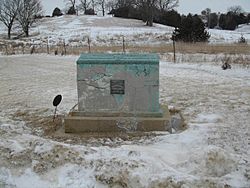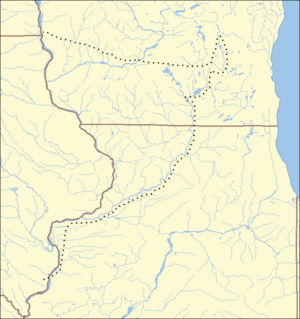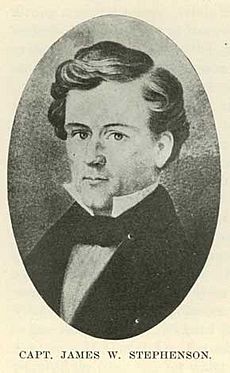Battle of Waddams Grove facts for kids
Quick facts for kids Battle of Waddams Grove |
|||||||
|---|---|---|---|---|---|---|---|
| Part of the Black Hawk War | |||||||
 The battle happened near this hill. The marker shows where William Waddams, the first permanent white settler in Stephenson County, built his cabin in 1832. |
|||||||
|
|||||||
| Belligerents | |||||||
| Sauk | |||||||
| Commanders and leaders | |||||||
| James W. Stephenson | |||||||
| Strength | |||||||
| 12+ | unknown | ||||||
| Casualties and losses | |||||||
| 3 killed | 2-6 killed | ||||||
The Battle of Waddams Grove, also known as the Battle of Yellow Creek, was a fight during the Black Hawk War. It took place on June 18, 1832, in what is now Stephenson County, Illinois.
Before the battle, Sauk Native Americans had raided settlements along the Apple River. Captain James W. Stephenson and a group of volunteer soldiers from Galena went after them. On June 18, 1832, the groups met near Yellow Creek. The fight turned into a close-quarters battle with bayonets and knife fights. Several Sauk warriors and three soldiers were killed. Captain Stephenson was badly wounded in the chest. The soldiers who died were later buried in a special cemetery in Kellogg's Grove, Illinois. A stone monument was built there to remember everyone killed in the war.
Why the Battle Happened
The Black Hawk War began because Black Hawk, a Sauk leader, was upset about losing his homeland. He believed the land was taken unfairly through old treaties. Starting in 1830, he led his people, known as the "British Band," across the Mississippi River into Illinois.
In April 1832, Black Hawk hoped other tribes and the British would join him. He moved his band of about 1,000 warriors and civilians into Illinois again. When he found no allies, he tried to return to Iowa. But events led to the Battle of Stillman's Run, the first major fight of the war. After this, more small battles happened. Soldiers from Wisconsin and Illinois were called to find Black Hawk's group. This conflict became known as the Black Hawk War.
After the Battle of Stillman's Run, there were exaggerated rumors. People heard that 2,000 "bloodthirsty warriors" were destroying northern Illinois. This caused a lot of fear. Several small attacks and skirmishes followed. Before the Battle of Horseshoe Bend, which happened two days before Waddams Grove, people didn't trust the soldiers much.
Events Leading to the Fight
On June 9, 1832, a group of Native Americans crossed the Mississippi River near Galena. They moved up the Apple River, taking food and horses. They stole about a dozen horses from a small fort. These Sauk raiding parties were gathering supplies for Black Hawk's main group. Black Hawk's band of 1,000 men, women, and children was camped in the swamps of southwestern Wisconsin. A few days later, another similar incident happened, though no one was hurt. This made the local soldiers decide to act.
| Map of Black Hawk War sites Symbols are wikilinked to article |
White settlers were very worried. Captain James W. Stephenson gathered 12 volunteers in Galena. They moved towards the area where the problems were happening. Stephenson got more men at Apple River Fort and then traveled east. On June 18, Stephenson and his men woke up before sunrise. They started following the trail of the Sauk group who had stolen the horses. The soldiers marched through heavy rain until they finally caught up with the Sauk.
The Battle Begins
Captain Stephenson found the Native American group on June 18, 1832. They were in an open area near Yellow Creek. This was about 12 miles (19 km) east of Kellogg's Grove, Illinois. At first, Stephenson's soldiers couldn't get a clear shot. The Sauk quickly moved into a wooded area near the creek for cover. The soldiers watched from what was probably West Point Hill.
Stephenson's men fired shots, but the Sauk did not shoot back right away. The fight soon became a close-quarters battle using bayonets and knives. The soldiers charged into the thick woods. The Sauk then returned fire, killing a soldier named Stephen P. Howard. The soldiers charged into the woods two more times. During one charge, Thomas Sublette wounded a Sauk warrior, and George Eames was killed. The third charge badly wounded Captain Stephenson, who was shot with a musket ball. Another soldier, Michael Lovell, was also killed. According to Captain Stephenson, five or six Native American warriors were killed. The soldiers lost three men.
The Sauk warriors had more fighters than Stephenson's group. The soldiers were forced to retreat. When they left, they took most of the horses that the Sauk had stolen earlier.
What Happened After
The battle allowed the soldiers to fight the Native Americans. However, it didn't fully stop the Native American raids in the area. The soldiers returned to Galena, Illinois, feeling proud of their victory. The battle helped improve how people viewed the soldiers. After the terrible defeat at Stillman's Run in May, the Battle of Yellow Creek, along with the Battle of Horseshoe Bend, showed that the soldiers could stand up to and defeat Black Hawk's warriors.
The soldiers killed at the Battle of Waddams Grove were eventually buried in a memorial cemetery at Kellogg's Grove. Their graves are under a large stone monument. This monument honors all the soldiers killed during the Black Hawk War. The battlefield itself is thought to be along Yellow Creek. It is northwest of William Waddams' original land claims, north of the small town of Waddams Grove, Illinois.



